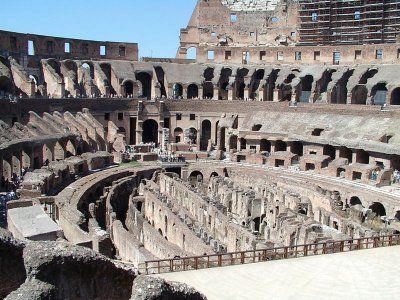amphitheater

The Colosseum in Rome.
An amphitheater was a spacious building, generally oval in form, used by the Romans for exhibiting gladiatorial contests, fights of wild animals, and other spectacles. The amphitheater differed from a theater for dramatic performances (theatrum) in that whereas the theater had only a semicircle of seats fronting the stage, the amphitheater was entirely encircled by them; hence the name (Greek amphi, "all round").
At first amphitheaters were made of wood and were temporary structures, like a modern race-stand. Yet they seem to have been of enormous size, as Tacitus mentions one at Fidenae, during the reign of Tiberius, whose collapse is said to have caused the death or injury of 50,000 spectators. Amphitheaters of stone had begun, however, to be erected at an earlier period than this, the first having been built in 31 BC under the instructions of Augustus.
The Flavian amphitheater in Rome, known as the Colosseum because of its great size, was begun by Vespasian, and finished by Titus in 80 AD. It was the largest structure of its kind, and is fortunately also the best preserved. It covers about five acres, and was able to seat 50,000 spectators. Its greatest length is 612 feet, and its greatest width 515 feet, the corresponding figures for the Albert Hall in London being 270 and 240. On the occasion of its dedication by Titus, 5,000 wild animals were slain in the arena, the games lasting nearly a hundred days.
The exterior of the Colosseum is about 160 feet in height, and consists of three rows of columns, Doric, Ionic, and Corinthian, and above all, a row of Corinthian pilasters. Between the columns there are arches, which form open galleries throughout the whole building; and between each alternate pilaster of the upper tier is a window. Besides the podium, there were three tiers or stories of seats, corresponding to the external stories. The first of these is supposed to have contained 24 rows of seats; and the second 16. These were separated by a lofty wall from the third story, which contained the populace. The podium was a gallery surrounding the arena, in which the emperor, the senators, and vestal virgins had their seats.
The building was covered by a temporary awning or wooden roof, called the velarium. The open space in the center of the amphitheater was called the arena, the Latin word for sand, because it was covered with sand or sawdust during the performances.
The taste for the excitement of the amphitheater at Rome naturally spread to the provinces, and large amphitheaters were erected not only in the provincial towns of Italy, as at Capua, Verona, Pompeii, Pozzuoli, etc., but also as Arles, Nîmes, and Frejus, in France; at Italica, near Seville, in Spain; and at Circencester, Silchester, and Dorchester, in England.
